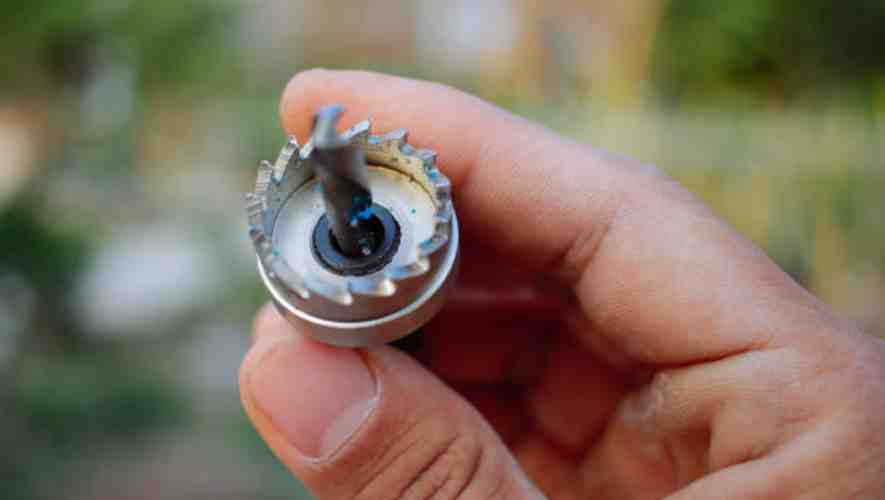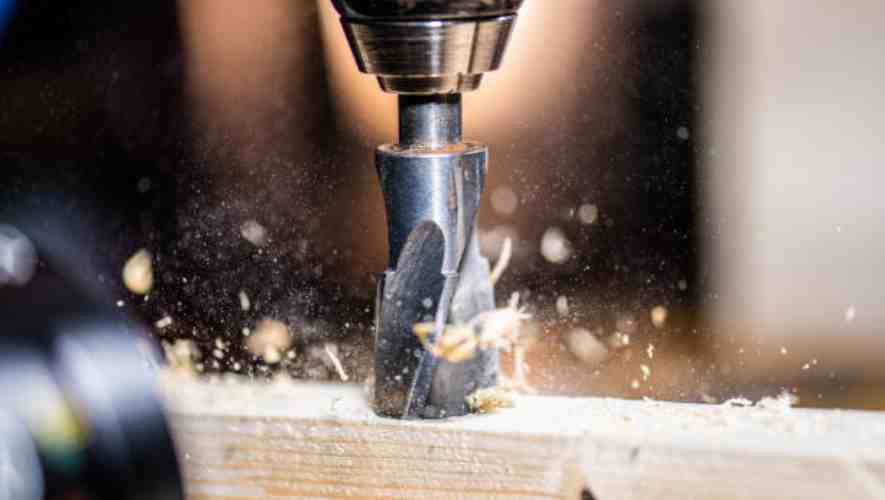If you’ve ever faced the challenge of splitting wood, whether for building projects or preparing firewood, you understand the importance of having the right tools for the job. The search for a more efficient and less labor-intensive method often leads to the question: “Do wood splitting drill bits work?” In our quest for an answer, we explore the effectiveness of these tools, considering factors like ease of use, safety, and their suitability for different types of wood.
Do Wood Splitting Drill bits work? Wood splitting drill bits are designed to attach to a standard drill, offering a convenient and less physically demanding alternative to traditional methods like using an axe or a maul. These bits are particularly effective for splitting small to medium-sized logs and are known for their precision and speed. Their efficiency may vary depending on the type of wood and the specific conditions of use.
The beauty of these bits lies in their simplicity and effectiveness, but how well do they really work in practice? This blog will delve into their mechanics, types, and best practices for use. We’ll also compare them to traditional wood splitting methods to give you a comprehensive understanding. By the end of this article, you’ll not only know if these drill bits are right for your needs, but also how to use them safely and effectively.
Design and Types of Wood Splitting Drill Bits

Material Composition and Structural Features
The effectiveness of wood splitting drill bits lies in their material composition and structural integrity. High-speed steel (HSS) is a common material, prized for its durability and ability to withstand high temperatures. Some bits incorporate carbide tips for enhanced hardness and longevity, useful in professional settings. The bits feature a pointed tip for initial penetration, followed by cutting edges that slice through the wood fibers. The flutes, or grooves, along the bit’s length play a crucial role in chip removal, preventing clogging and maintaining efficiency.
Different Types and Their Specific Uses
Each type of wood splitting drill bit serves a unique purpose, catering to various woodworking needs. Auger bits, with their helical design, are perfect for deep, precise drilling in hardwoods, ideal for furniture making and cabinetry. Spade bits, with their broader cutting surface, are favored for rapid drilling in softwoods, often used in construction for framing and utility work. Forstner bits, with their precision cutting edges, are the go-to choice for doweling, cabinetry, and anywhere a clean, flat-bottomed hole is required. Understanding the specific use of each bit type ensures optimal performance and results in woodworking projects.
Advancements in Drill Bit Technology for Enhanced Efficiency
The field of wood splitting drill bits has witnessed significant technological advancements, enhancing efficiency and user experience. Modern bits now feature coatings such as titanium nitride (TiN) or diamond powder, which reduce wear and extend the bit’s lifespan. The geometry of the bits has also evolved, with innovative designs that improve chip removal and reduce drilling effort. Some contemporary bits include self-feeding tips and variable pitch angles, making them more efficient and user-friendly, in professional woodworking and carpentry scenarios.
Mechanism of Action: How Wood Splitting Drill Bits Work
The mechanism of action for wood splitting drill bits is a blend of cutting and chiseling. As the bit rotates, its sharp edges cut through the wood fibers, while the spiraled flutes facilitate the removal of wood chips. This action reduces the friction and heat build-up, allowing for smoother drilling. The tip of the bit initiates the penetration, guiding the bit through the material. As the cutting edges engage, they slice through the wood, either chiseling out a cylindrical piece in the case of auger and Forstner bits, or shaving off layers in the case of spade bits. This efficient mechanism ensures clean, precise holes with minimal effort.
Understanding the Working Principle

In wood splitting, the distribution of force and the identification of stress points are crucial for efficient splitting. When force is applied, it is concentrated at the edge of the splitting tool, creating a stress point that initiates the split.
The force then radiates outward, following the wood’s natural grain. This distribution is uneven, as wood has varying densities and knots, which can alter the path of the split. Understanding these dynamics helps in designing tools that can more effectively target stress points and distribute force in a manner that optimizes the splitting process
Comparing modern wood splitting tools with traditional ones, such as axes and mauls, reveals significant advancements. Traditional tools rely heavily on the user’s strength and skill to direct force efficiently.
Modern tools often incorporate mechanical advantages, such as hydraulic systems in log splitters, to multiply force and reduce the physical effort required.. The design of contemporary tools frequently includes ergonomic considerations to minimize user fatigue and injury risk. This comparative study highlights the evolution of wood splitting tools, focusing on increased efficiency, safety, and ease of use.
Applications and Effectiveness

Common Applications in Professional and DIY Projects
Woodworking is a versatile field, blending both professional and DIY projects. In professional settings, woodworking is essential for furniture making, cabinetry, and architectural woodwork. These projects demand precision and expertise. Conversely, DIY woodworking has surged in popularity, focusing on home improvement, custom furniture, and creative crafts. Both realms leverage a variety of tools and techniques, showcasing the adaptability of woodworking in different contexts.
Effectiveness in Different Types of Wood
The effectiveness of woodworking significantly varies with the type of wood used. Hardwoods like oak and maple are renowned for their durability and are commonly used in high-end furniture and flooring. These woods require specific tools and techniques due to their density. Softwoods, such as pine and cedar, are preferred for their workability and cost-effectiveness, making them ideal for a range of projects from framing to decorative items. Understanding the properties of each wood type is crucial for achieving desired outcomes.
Case Studies and User Experiences
Analyzing case studies and user experiences provides valuable insights into the practical aspects of woodworking. For instance, a case study on custom furniture making can highlight the meticulous process of selecting wood, designing, and crafting. User experiences from DIY enthusiasts often shed light on innovative techniques and personal learnings. These narratives not only offer guidance but also inspire new ideas and approaches in both professional and amateur woodworking circles.
Advantages and Limitations

Pros: Time Efficiency, Ease of Use, Precision
One of the most significant advantages of modern systems is their ability to save time. These systems often automate tasks that were previously labor-intensive, thereby streamlining operations and boosting productivity.They are designed with user-friendliness in mind, making them accessible to a broad range of users regardless of their technical expertise. This ease of use does not compromise precision; in fact, these systems are celebrated for their high level of accuracy, which is essential in fields where minute details are critical.
Cons: Equipment Cost, Maintenance Requirements, Limitations in Application
There are several drawbacks to consider. The initial cost of purchasing advanced equipment can be prohibitively high, for small businesses or individuals. These systems often require regular maintenance, which can incur additional costs and downtime. Another limitation is that they might not be suitable for all applications. Sometimes, the specific requirements of a task or the uniqueness of a project might render these advanced systems less effective or even unusable.
Safety Considerations and Best Practices
Ensuring safety when using such sophisticated systems is paramount. It’s crucial to adhere to all safety guidelines and regularly train users to handle the equipment correctly. This involves staying updated on the latest safety protocols and incorporating regular safety drills and checks. Best practices also include routine maintenance and inspections of the equipment to prevent accidents caused by malfunctioning machinery. By prioritizing safety and adhering to best practices, users can mitigate risks and ensure a secure working environment.
Conclusion
Wood splitting drill bits, when used correctly, can significantly simplify the task of splitting wood. They are a testament to modern ingenuity in tools, combining efficiency with ease of use. Their effectiveness is contingent on factors like wood type and bit quality.
In conclusion, wood splitting drill bits are a valuable tool for anyone looking to streamline their wood splitting process. They offer a unique blend of efficiency and convenience, but it’s important to choose the right bit for your specific needs and to use them safely. Remember, no tool is a one-size-fits-all solution, but with the right knowledge and approach, wood splitting drill bits can be a game-changer in your toolkit. Whether you’re a seasoned woodworker or a casual DIY enthusiast, embracing this modern approach to an age-old task can bring both satisfaction and impressive results.

